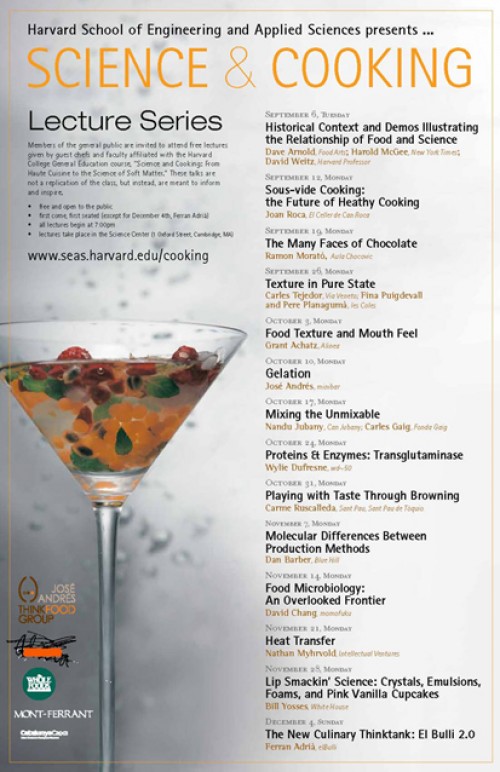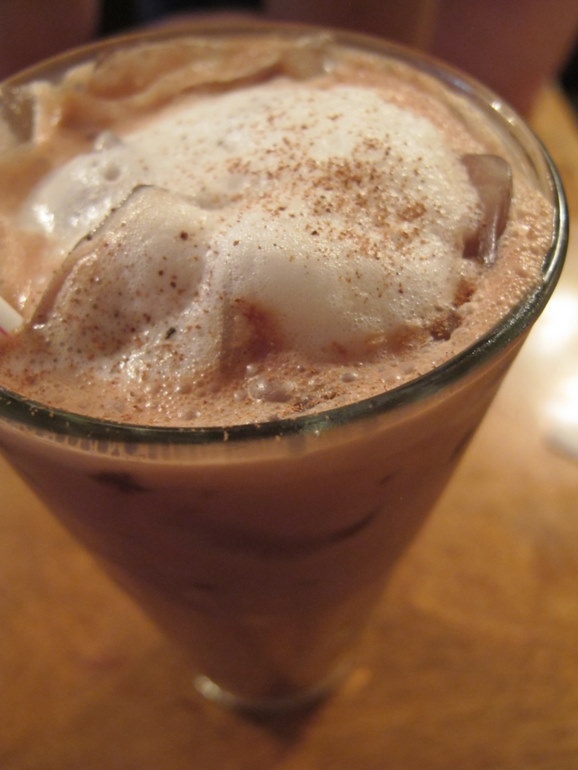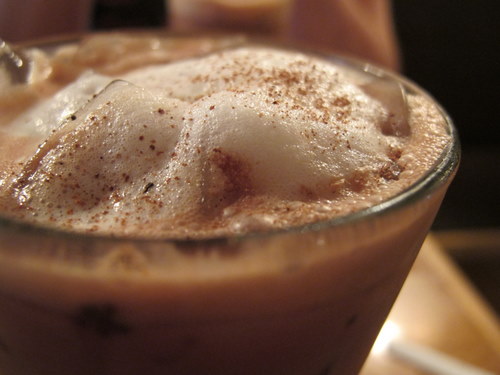Wacky World of Choc Wednesdays: Chocolate, China, and Basketball
Here’s something fun for sporty chocolate fans. Beantown favorite Paul Pierce, of the (17-time World Champion!!!) Boston Celtics, on a recent trip to China, was immortalized with a commemorative chocolate figurine.
On August 26, Pierce, also known as The Truth, tweeted a photograph of the figurine, captioning it “The chocolate Truth.” Here it is:
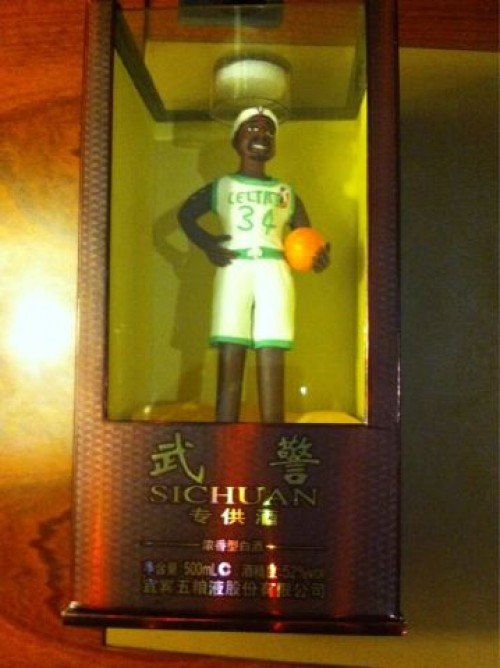
He also tweeted the following image of himself with his commemorative chocolate figurine:
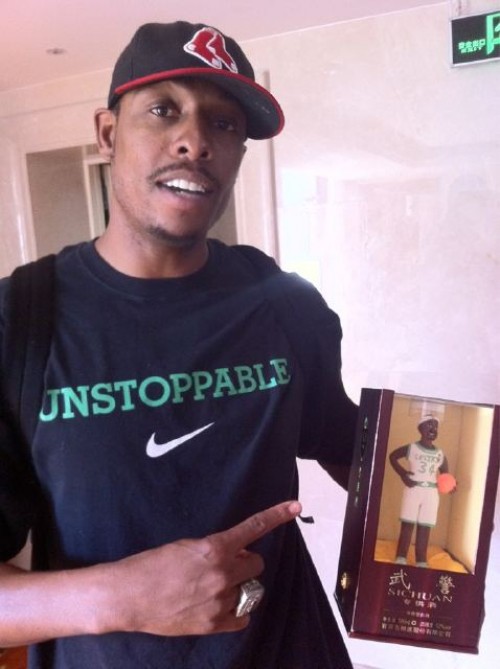
This is totally awesome. It also raises a lot of questions. How is it that, in the past several years, basketball has gained such popularity in China that an NBA star’s visit would bring about a promotional figurine? Why might a figurine in China be made out of chocolate? (See also China’s Chocolate War.) Moreover, it seems plain to me, but others might not agree — racial factors are at play here, intentionally or otherwise, are they not? Put more simply, would Larry Bird’s figurine have been made out of white chocolate? For more on the complexities of chocolate and race, see Cadbury’s ill-fated advertising campaign in 2009. Oh, and then again in 2011. This is just the tip of the iceberg. How does this figurine exemplify or differ from the other ways that chocolate is used in ritual or commemoration? And, for those of you who experience a certain sadness when eating chocolate bunnies, would you do the humane thing and eat Pierce’s figurine head first?
Here are nearly five minutes of excellent reasons for Pierce’s commemoration:
While we’re at it, check out Pierce’s inspirational campaign:
Paul Pierce’s Truth on Health campaign empowers and encourages young people to lead healthier lives by providing them with the information, resources, and tools necessary to become more active and physically fit. To learn more, visit www.truthonhealth.org.
Yeah, the world of chocolate is wacky.
Harvard’s Science and Cooking Class returns, chocolate on the menu again
In the fall of 2010, Harvard’s School of Engineering and Applied Sciences (SEAS) and the Alícia Foundation debuted a new general education class called Science and Cooking: From Haute Cuisine to Soft Matter Science. The subject matter was incredibly popular — approximately 700 undergraduates lotteried for 300 spots and hundreds of local citizens attended the crowded public lectures. The course itself became a celebrity of sorts in the press. The good news is that this year, they’re doing it all again. Science and Cooking is back for a second semester with another rocking list of famous lecturers.
Class instructors Professor David Weitz and Preceptor Pia Sörensen definitely have their priorities straight, as with only thirteen lecture slots available they have managed to fit in an entire evening devoted to chocolate. On Monday, September 19, 2011, at 7pm, speaker Ramon Morató of Aula Chocovic will present a lecture entitled “The Many Faces of Chocolate.”
Click here for more information on the class. As detailed on the course website, evening lectures are open to the general public and are also made available for viewing on iTunes U and YouTube.
As an observer from Harvard’s social sciences and humanities flank, I was thrilled by several things about the first installment of Science and Cooking. First, the class was designed as a collaboration amongst a diverse group of people and organizations — faculty and graduate student teaching staff, some of the world’s best known chefs and food science experts, educational institutions, local businesses, and undergraduate learners. Second, the class incorporated a hands-on lab component that took lecturing, reading, and abstract thinking about science and cooking into real world observation and experimentation. Third, the evening lectures were open to the general public. (This turned out to be tricky because interest was high and space was limited, but the problem was quickly solved when lecture videos were put online for all to see. This year, the course has also found a bigger lecture hall.). “Now this is how learning should happen!” I cheered.
Of course, being from said social sciences and humanities flank, I was all the while asking silent questions of the class, some casually critical. Why are so many of the chefs for this class European/Caucasian? Why are so many of them male? Whose cooking is this class about? Is modernist cuisine perhaps over represented? Could this type of class even be offered elsewhere (without the brand, the $$$, the snazzy PR)? Will students be introduced to the environmental science that affects the food that they will ultimately cook? Or the health and nutrition science that will in many ways define their quality of life? Or even the social science that could help them to understand the people and cultural traditions involved at every stage of science and cooking? Hmmm…
I could go on and on, but really, who asked me anyway? One class can’t actively teach everything all at once. The related issues that concern me actually came up over and over again on their own – audience members and students asked about them and, while the occasional lecturer balked at the idea of getting political in a science class, many responded passionately and were enthusiastic to share their knowledge and opinions. A number of my former students who took Science and Cooking approached me in one-on-one meetings to chat about the class and how it related to what we had studied together. Once again, I was thrilled. A successful learning experience encourages curiosity in students to further investigate their world. As food studies become more prominent on college campuses, more classes addressing these issues are being developed and offered. Science and Cooking is a very important step along the way; it serves as a jumping off point for many other discussions, and it has undoubtedly inspired me and countless others to dream big about food and education.
Happily for us chocolate lovers, two of the lectures last year dealt with chocolate and they are available to watch online. Enjoy!
- White House pastry chef Bill Yosses presented a lecture entitled “Brain Candy: How Desserts Slow the Passage of Time,” on October 28, 2010. Yosses’ engaging lecture takes viewers through the making of chocolate mousse, sharing lots of useful chocolate science notes and even a few tidbits about the chocolate preferences of the First Couple.
- Enric Rovira, the Barcelona-based chocolatier, presented a lecture entitled “Heat, Temperature and Chocolate,” on November 12, 2010. While Rovira’s lecture does not go into great scientific detail, it does give an overview of his gorgeous line of chocolates and his collaboration with chocolate maker Claudio Corallo.
A favorite summer treat: L.A. Burdick’s iced hot chocolate
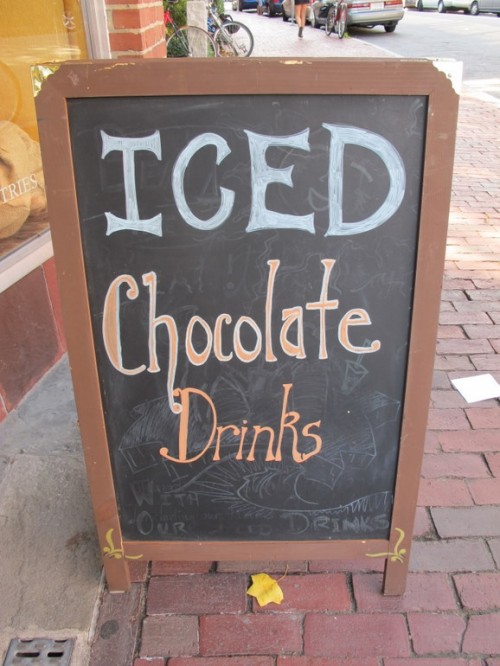
It pains me to acknowledge it, but summer is eventually going to end. In the not distant future, the air will turn crisp and whisper of autumn. But before the last of the hot, sunny days disappear, I’m determined to fit in as much summer fun as possible.
One of my favorite summer treats is iced hot chocolate. For over a decade now, my go-to iced hot chocolate spot has been the L.A. Burdick cafe in Harvard Square in Cambridge, Massachusetts. Burdick uses Valrhona chocolate in their standard chocolate drinks, and more recently has added a line of single source chocolate options. Lately, I’m partial to the Madagascan for drinking; the Burdick menu describes it as “Madagascan: 64% chocolate with a very sharp fruity acidity with hints of citrus and vanilla. Medium body wih a long finish.” Translation: MELTED YUM!
Perhaps the most fun, though, comes in introducing someone to the drink for the first time. Too often my friends and colleagues squeal “Iced hot chocolate?! Who knew? Oh, the deliciousness!” as though their lives have been forever changed by the experience. And I can’t help but chuckle and roll my eyes when I hear the familiar “Iced hot chocolate? Isn’t that an oxymoron?” Poor little rich kids trapped in a literal world…
It’s possible that the literalists are thinking “Isn’t this just… chocolate milk?” In fact, it is so. much. more. Burdick’s prepares the iced hot chocolate by first melting chocolate shavings in steamed or scalded milk, then pouring the hot mixture over ice. They’ll even add whipped cream and a sprinkling of cocoa powder on top, if you fancy. In an epic battle of chocolate milk vs. iced hot chocolate, iced hot chocolate would claim an easy victory. (More on this in a future post.)
I credit the Cambridge L.A. Burdick cafe with introducing me to my first tastes of fine chocolate back when I was just a wee teenage choco fangirl, and for showing me that there was a vast world of flavor to explore. One of my dearest friends worked at the cafe for nearly a decade. Lover of a good story that I am, I relished the opportunity to hear the “backstage” talk at the cafe, from how the chocolates were made to what quirky customers would sometimes say or do. (More on the Burdick company in a future post, too.)
So, if you’re in the Boston area, I highly recommend a trip to Harvard Square to taste this special drink. Good luck resisting the pastries and bonbons while you’re there.
L.A. Burdick Chocolate Cafe
52 Brattle St., Harvard Square
Cambridge, MA 02138
phone: 617-491-4340
Sun-Thurs 8am-9pm
Fri-Sat 8am-10pm
(Burdick also has locations in Walpole, NH and New York, NY)
Or, you can make iced hot chocolate on your own with one of these recipes:
L.A. Burdick’s Iced Hot Chocolate
David Lebovitz’s Iced Chocolate (As a New Englander, I would technically dub this a souped up chocolate frappe because of the ice cream… Eh, technicalities. It is awesome.)
Summer, please stay just a little bit longer.
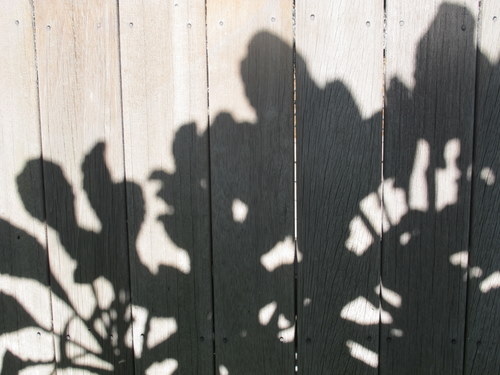
Wacky World of Choc Wednesdays: The Cacao Rap
Oh dear…
“The Cacao Rap” from Christian Bates and Irresistible Health.
Lyrics are available here.
Wacky World of Choc Wednesdays: Cocoa pod coffin, Kane Kwei (c. 1970)
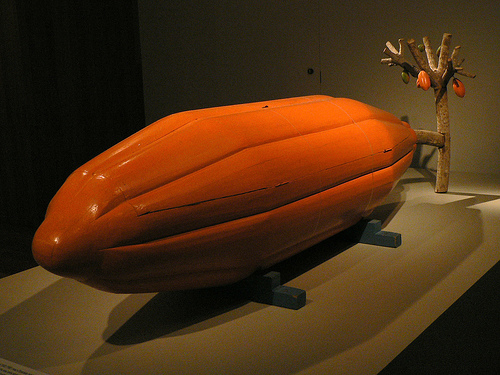
Cocoa pod coffin, photo by Christina B. Castro
This coffin in the shape of a cocoa pod is on exhibit at San Francisco’s de Young Museum.
Museum notes:
Kane Kwei
Coffin in the shape of a cocoa pod
Ghana, Teshi, Ga people
Ca. 1970
Wood, paint, cloth
Gift of Vivian Burns, Inc.Kane Kwei (1927-1992) was a Ghanaian artist who lived in the city of Teshie, near Accra. He was once apprenticed to a carpenter and sometimes made coffins, which traditionally were straight-sided rectangular boxes. When Kwei’s dying uncle, a fisherman, asked him for a special coffin, he made one in the shape of a boat. Soon other customers asked Kwei to build representational coffins, the subjects always alluding to their lifetime trades or status. The most popular early shapes were boats, fish, mother hens with chicks, onions, and cocoa pods (in the 1970s Ghana was the world’s largest cocoa producer).
Unlike most traditional African art, Kane Kwei’s coffins are pieced together like European furniture rather than carved from a single piece of wood. They are finished with enamel paint. Each one has a hinged lid and an upholstered interior (satin, velvet, or tie-dyed), including a mattress and pillow.
Suggested reading:
Ghana Coffin: Kane Kwei Carpentry Workshop, a site built by visitors to the Kane Kwei workshop in Ghana.
Funeral chic: Colorful coffins convey the deceased’s interests, profession, an article introducing these types of coffins and their connection to northern California.
Going out on a high: The master sculptor who turns caskets into works of art in the shape of fish, birds… and even aeroplanes, an article about a coffin gallery exhibit in London.
Two Journeys: The Deaths and Lives of Ga ‘Fantasy Coffins’, a longer piece that contextualizes Ghanaian funeral traditions and the question of funeral coffins as art.
This piece, traditional or not, art or not, pushes me to think more on the flexibility of funeral customs, symbolic objects and the deceased, and the relationship between chocolate and grief.
